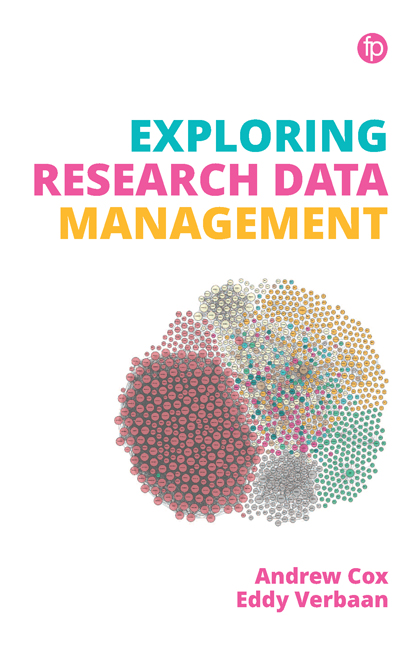Book contents
- Frontmatter
- Contents
- List of tables and figures
- 1 Introducing Research Data Management
- 2 The Social Worlds of Research
- 3 What Are Research Data?
- 4 Case Study of RDM in an Environmental Engineering Science Project
- 5 RDM: Drivers and Barriers
- 6 RDM as a Wicked Challenge
- 7 Research Data Services
- 8 Staffing a Research Data Service
- 9 Requirements Gathering for a Research Data Service
- 10 Institutional Policy and the Business Case for Research Data Services
- 11 Support and Advice for RDM
- 12 Practical Data Management
- 13 Data Management Planning
- 14 Advocacy for Data Management and Sharing
- 15 Training Researchers and Data Literacy
- 16 Infrastructure for Research Data Storage and Preservation
- 17 Evaluation of RDS
- 18 Ethics and Research Data Services
- 19 A Day in the Life Working in an RDS
- 20 Conclusion: the Skills and Mindset to Succeed in RDM
- Index
16 - Infrastructure for Research Data Storage and Preservation
Published online by Cambridge University Press: 21 September 2019
- Frontmatter
- Contents
- List of tables and figures
- 1 Introducing Research Data Management
- 2 The Social Worlds of Research
- 3 What Are Research Data?
- 4 Case Study of RDM in an Environmental Engineering Science Project
- 5 RDM: Drivers and Barriers
- 6 RDM as a Wicked Challenge
- 7 Research Data Services
- 8 Staffing a Research Data Service
- 9 Requirements Gathering for a Research Data Service
- 10 Institutional Policy and the Business Case for Research Data Services
- 11 Support and Advice for RDM
- 12 Practical Data Management
- 13 Data Management Planning
- 14 Advocacy for Data Management and Sharing
- 15 Training Researchers and Data Literacy
- 16 Infrastructure for Research Data Storage and Preservation
- 17 Evaluation of RDS
- 18 Ethics and Research Data Services
- 19 A Day in the Life Working in an RDS
- 20 Conclusion: the Skills and Mindset to Succeed in RDM
- Index
Summary
Aims
The aim of this chapter is to outline the infrastructure required for RDM, particularly a repository for sharing data. This is as much about processes and policies as technologies.
Technical infrastructure
Developing and maintaining a technical infrastructure to support research data management is not the goal of institutional RDM, but it is a significant means to achieve the kind of behavioural change that is likely to be the real objective. It does this by enabling researchers to plan their data management from the start of a project, to look after their primary research data whilst they are working on a project, and to support the long-term preservation and sharing of those data. Each stage of this cycle may have its dedicated supporting technical infrastructure, for example:
• an online data management planning tool
• a means for the secure storage of primary research data whilst the project is ongoing, giving access to those who need it, thus facilitating the sharing of data amongst a project team
• and finally, a facility to store data for long-term preservation and, where possible, to share those data with the wider community.
Again, although repository (including preservation and sharing) systems have often been the focus of research data management projects, it is important to realise that they really are only the end point, where a selection of the primary research data produced by a research project will find a permanent home, for example at the point of publication or when the project is wrapped up. This chapter focuses on this end point: a repository for long-term preservation and data sharing.
The repository
A repository is likely to have three components:
a catalogue
physical storage
file format preservation.
The catalogue and storage functionality are part and parcel of any repository solution, yet in some circumstances an institution may only need a catalogue of assets, and may not prioritise preservation. In some cases it may be worth investing in separate software that manages long-term preservation of the data files by monitoring the file formats that are in use, assessing their obsolescence and facilitating their migration to other file formats when needed.
- Type
- Chapter
- Information
- Exploring Research Data Management , pp. 147 - 158Publisher: FacetPrint publication year: 2018



